Page 3 of 703
TABLE OF CONTENTSSECTIONPAGE
1
INTRODUCTION .............................................................3
2
THINGS TO KNOW BEFORE STARTING YOUR VEHICLE .............................9
3
UNDERSTANDING THE FEATURES OF YOUR VEHICLE ............................129
4
UNDERSTANDING YOUR INSTRUMENT PANEL ..................................311
5
STARTING AND OPERATING .................................................457
6
WHAT TO DO IN EMERGENCIES ..............................................561
7
MAINTAINING YOUR VEHICLE ...............................................607
8
MAINTENANCE SCHEDULES .................................................661
9
IF YOU NEED CONSUMER ASSISTANCE ........................................669
10
INDEX ....................................................................679
1
2
3
4
5
6
7
8
9
10
Page 6 of 703

INTRODUCTION
Congratulations on selecting your new Chrysler Group
LLC vehicle. Be assured that it represents precision
workmanship, distinctive styling, and high quality - all
essentials that are traditional to our vehicles.
This Owner’s Manual has been prepared with the assis-
tance of service and engineering specialists to acquaint
you with the operation and maintenance of your vehicle.
It is supplemented by Warranty Information, and various
customer-oriented documents. Please take the time to
read these publications carefully. Following the instruc-
tions and recommendations in this manual will help
assure safe and enjoyable operation of your vehicle.
NOTE: After reviewing the owner information, it
should be stored in the vehicle for convenient referenc-
ing and remain with the vehicle when sold.When it comes to service, remember that your authorized
dealer knows your vehicle best, has factory-trained tech-
nicians and genuine parts, and cares about your satisfac-
tion.
HOW TO USE THIS MANUAL
Consult the Table of Contents to determine which section
contains the information you desire.
Since the specification of your vehicle depends on the
items of equipment ordered, certain descriptions and
illustrations may differ from your vehicle’s equipment.
The detailed index at the back of this Owner’s Manual
contains a complete listing of all subjects.
Consult the following table for a description of the
symbols that may be used on your vehicle or throughout
this Owner’s Manual:
4 INTRODUCTION
Page 97 of 703
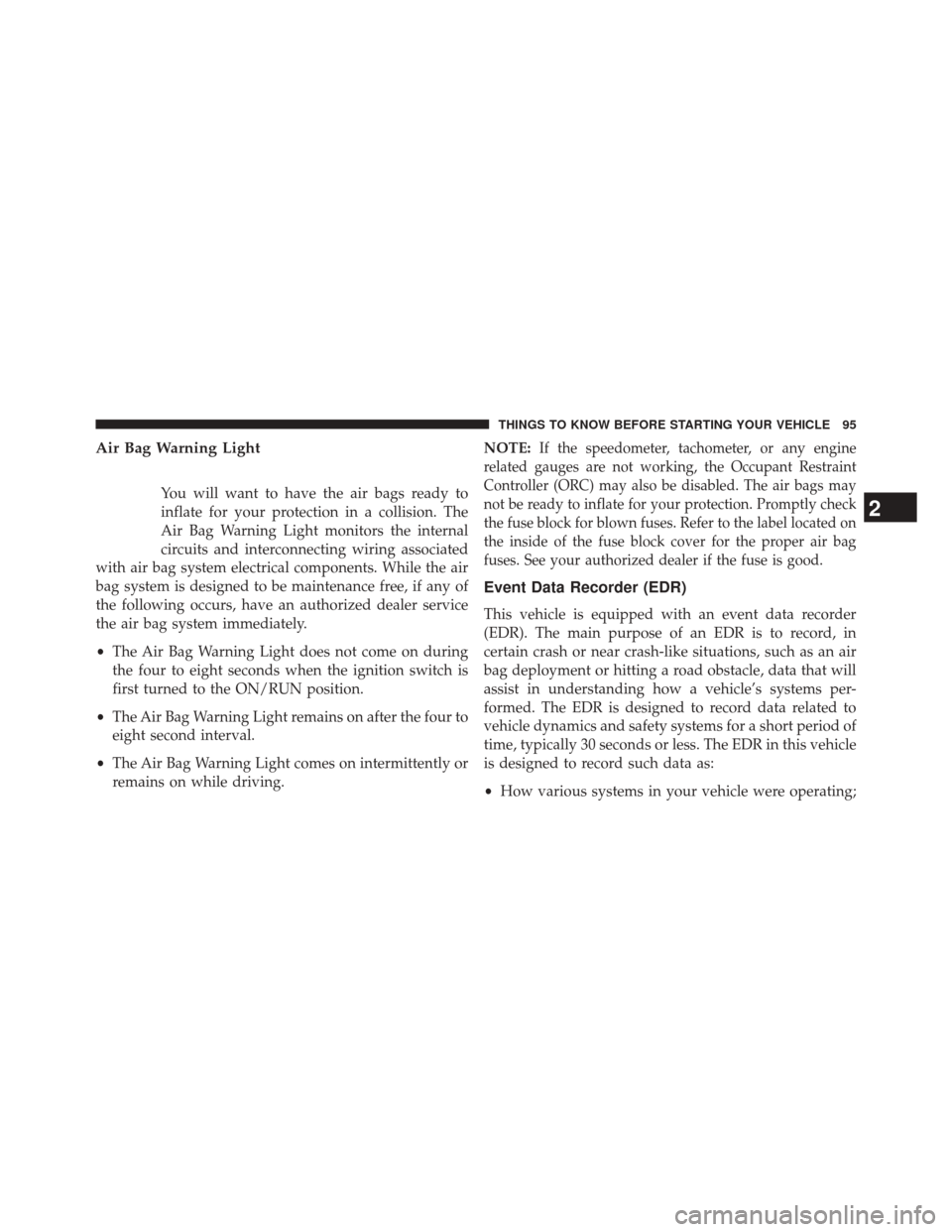
Air Bag Warning Light
You will want to have the air bags ready to
inflate for your protection in a collision. The
Air Bag Warning Light monitors the internal
circuits and interconnecting wiring associated
with air bag system electrical components. While the air
bag system is designed to be maintenance free, if any of
the following occurs, have an authorized dealer service
the air bag system immediately.
• The Air Bag Warning Light does not come on during
the four to eight seconds when the ignition switch is
first turned to the ON/RUN position.
• The Air Bag Warning Light remains on after the four to
eight second interval.
• The Air Bag Warning Light comes on intermittently or
remains on while driving. NOTE:
If the speedometer, tachometer, or any engine
related gauges are not working, the Occupant Restraint
Controller (ORC) may also be disabled. The air bags may
not be ready to inflate for your protection. Promptly check
the fuse block for blown fuses. Refer to the label located on
the inside of the fuse block cover for the proper air bag
fuses. See your authorized dealer if the fuse is good.
Event Data Recorder (EDR)
This vehicle is equipped with an event data recorder
(EDR). The main purpose of an EDR is to record, in
certain crash or near crash-like situations, such as an air
bag deployment or hitting a road obstacle, data that will
assist in understanding how a vehicle’s systems per-
formed. The EDR is designed to record data related to
vehicle dynamics and safety systems for a short period of
time, typically 30 seconds or less. The EDR in this vehicle
is designed to record such data as:
• How various systems in your vehicle were operating;
2
THINGS TO KNOW BEFORE STARTING YOUR VEHICLE 95
Page 124 of 703
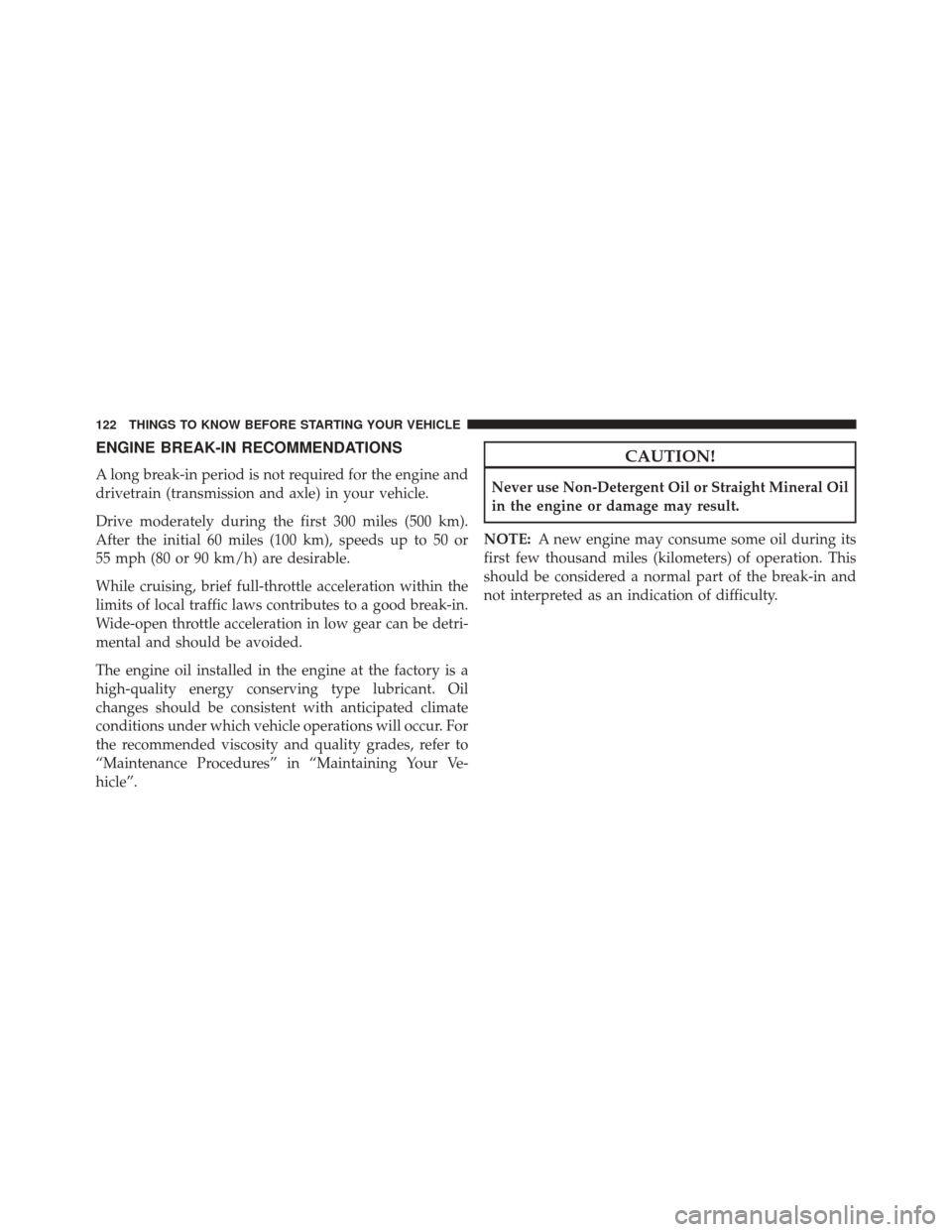
ENGINE BREAK-IN RECOMMENDATIONS
A long break-in period is not required for the engine and
drivetrain (transmission and axle) in your vehicle.
Drive moderately during the first 300 miles (500 km).
After the initial 60 miles (100 km), speeds up to 50 or
55 mph (80 or 90 km/h) are desirable.
While cruising, brief full-throttle acceleration within the
limits of local traffic laws contributes to a good break-in.
Wide-open throttle acceleration in low gear can be detri-
mental and should be avoided.
The engine oil installed in the engine at the factory is a
high-quality energy conserving type lubricant. Oil
changes should be consistent with anticipated climate
conditions under which vehicle operations will occur. For
the recommended viscosity and quality grades, refer to
“Maintenance Procedures” in “Maintaining Your Ve-
hicle”.
CAUTION!
Never use Non-Detergent Oil or Straight Mineral Oil
in the engine or damage may result.
NOTE: A new engine may consume some oil during its
first few thousand miles (kilometers) of operation. This
should be considered a normal part of the break-in and
not interpreted as an indication of difficulty.
122 THINGS TO KNOW BEFORE STARTING YOUR VEHICLE
Page 136 of 703
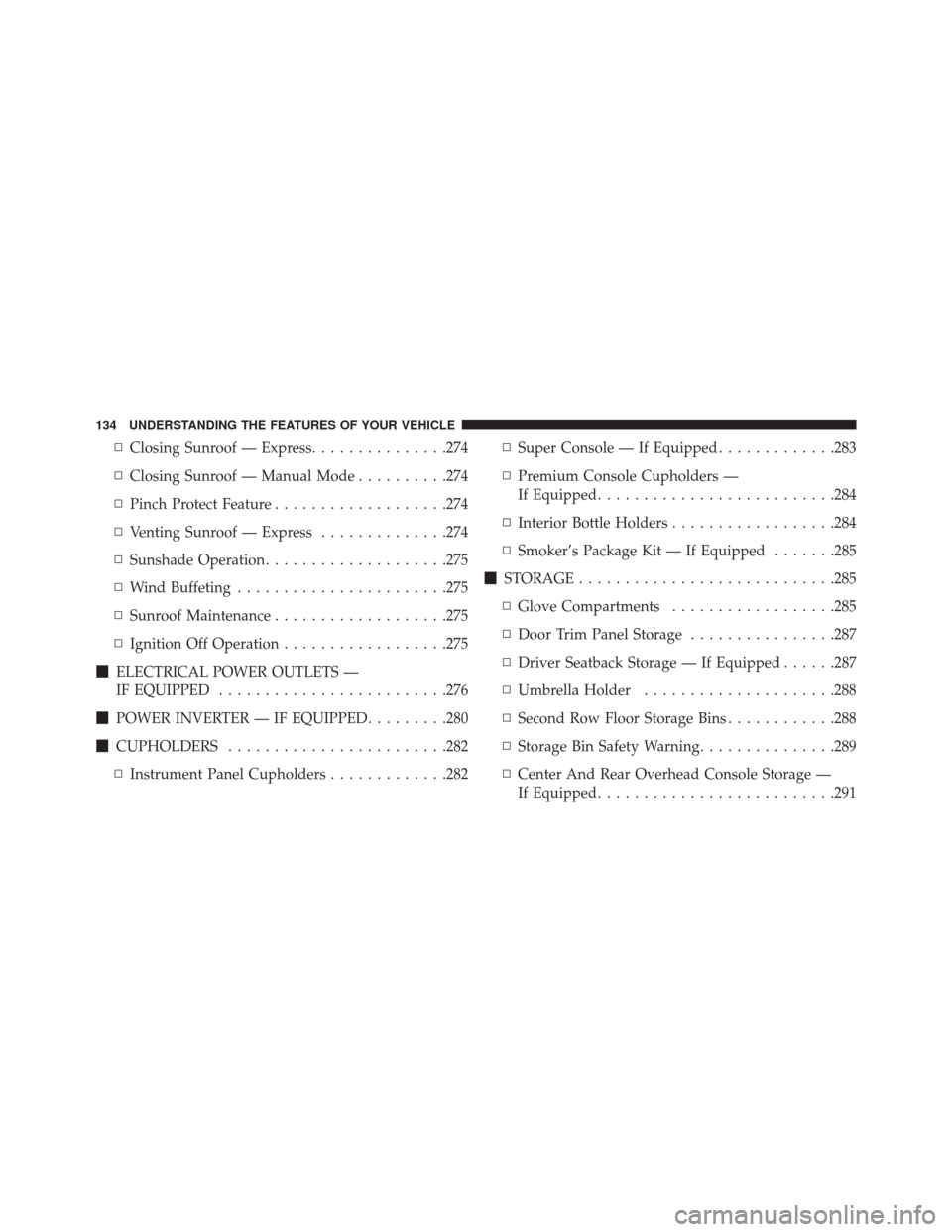
▫Closing Sunroof — Express ...............274
▫ Closing Sunroof — Manual Mode ..........274
▫ Pinch Protect Feature ...................274
▫ Venting Sunroof — Express ..............274
▫ Sunshade Operation ....................275
▫ Wind Buffeting ...................... .275
▫ Sunroof Maintenance ...................275
▫ Ignition Off Operation ..................275
� ELECTRICAL POWER OUTLETS —
IF EQUIPPED ........................ .276
� POWER INVERTER — IF EQUIPPED .........280
� CUPHOLDERS ....................... .282
▫ Instrument Panel Cupholders .............282▫
Super Console — If Equipped .............283
▫ Premium Console Cupholders —
If Equipped ......................... .284
▫ Interior Bottle Holders ..................284
▫ Smoker’s Package Kit — If Equipped .......285
� STORAGE ........................... .285
▫ Glove Compartments ..................285
▫ Door Trim Panel Storage ................287
▫ Driver Seatback Storage — If Equipped ......287
▫ Umbrella Holder .....................288
▫ Second Row Floor Storage Bins ............288
▫ Storage Bin Safety Warning ...............289
▫ Center And Rear Overhead Console Storage —
If Equipped ......................... .291
134 UNDERSTANDING THE FEATURES OF YOUR VEHICLE
Page 277 of 703
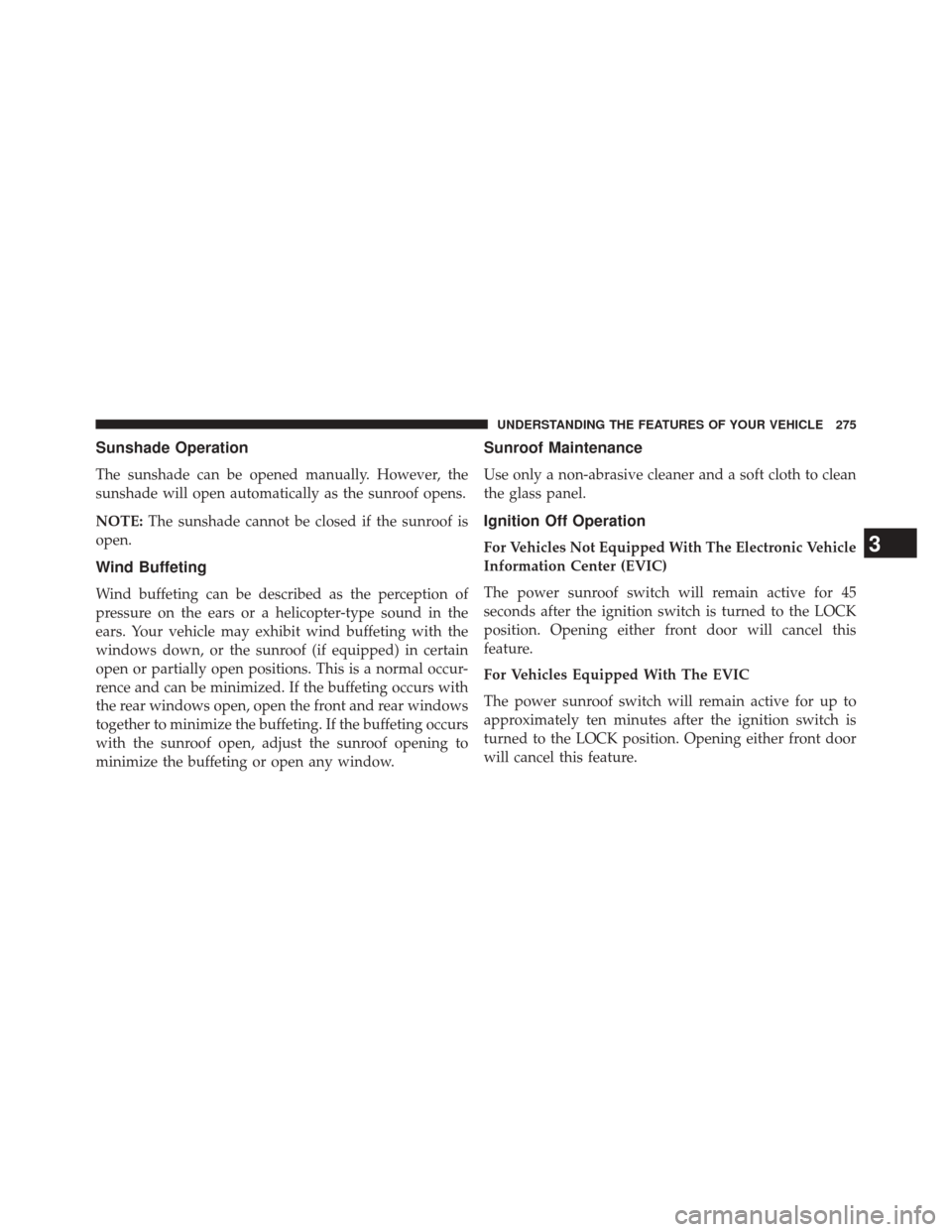
Sunshade Operation
The sunshade can be opened manually. However, the
sunshade will open automatically as the sunroof opens.
NOTE:The sunshade cannot be closed if the sunroof is
open.
Wind Buffeting
Wind buffeting can be described as the perception of
pressure on the ears or a helicopter-type sound in the
ears. Your vehicle may exhibit wind buffeting with the
windows down, or the sunroof (if equipped) in certain
open or partially open positions. This is a normal occur-
rence and can be minimized. If the buffeting occurs with
the rear windows open, open the front and rear windows
together to minimize the buffeting. If the buffeting occurs
with the sunroof open, adjust the sunroof opening to
minimize the buffeting or open any window.
Sunroof Maintenance
Use only a non-abrasive cleaner and a soft cloth to clean
the glass panel.
Ignition Off Operation
For Vehicles Not Equipped With The Electronic Vehicle
Information Center (EVIC)
The power sunroof switch will remain active for 45
seconds after the ignition switch is turned to the LOCK
position. Opening either front door will cancel this
feature.
For Vehicles Equipped With The EVIC
The power sunroof switch will remain active for up to
approximately ten minutes after the ignition switch is
turned to the LOCK position. Opening either front door
will cancel this feature.3
UNDERSTANDING THE FEATURES OF YOUR VEHICLE 275
Page 317 of 703
�CD/DVD/Blu-ray™ Disc MAINTENANCE . . . .436
� RADIO OPERATION AND MOBILE PHONES . .437
� CLIMATE CONTROLS ...................437
▫ Manual Heating And Air Conditioning System —
If Equipped ........................ .437
▫
Rear Manual Climate Control — If Equipped . . . .443
▫ Automatic Temperature Control (ATC) —
If Equipped ........................ .445▫
Summer Operation ....................455
▫ Winter Operation ..................... .455
▫ Vacation/Storage ..................... .456
▫ Window Fogging .....................456
▫ Outside Air Intake .....................456
▫ A/C Air Filter ...................... .456
4
UNDERSTANDING YOUR INSTRUMENT PANEL 315
Page 324 of 703
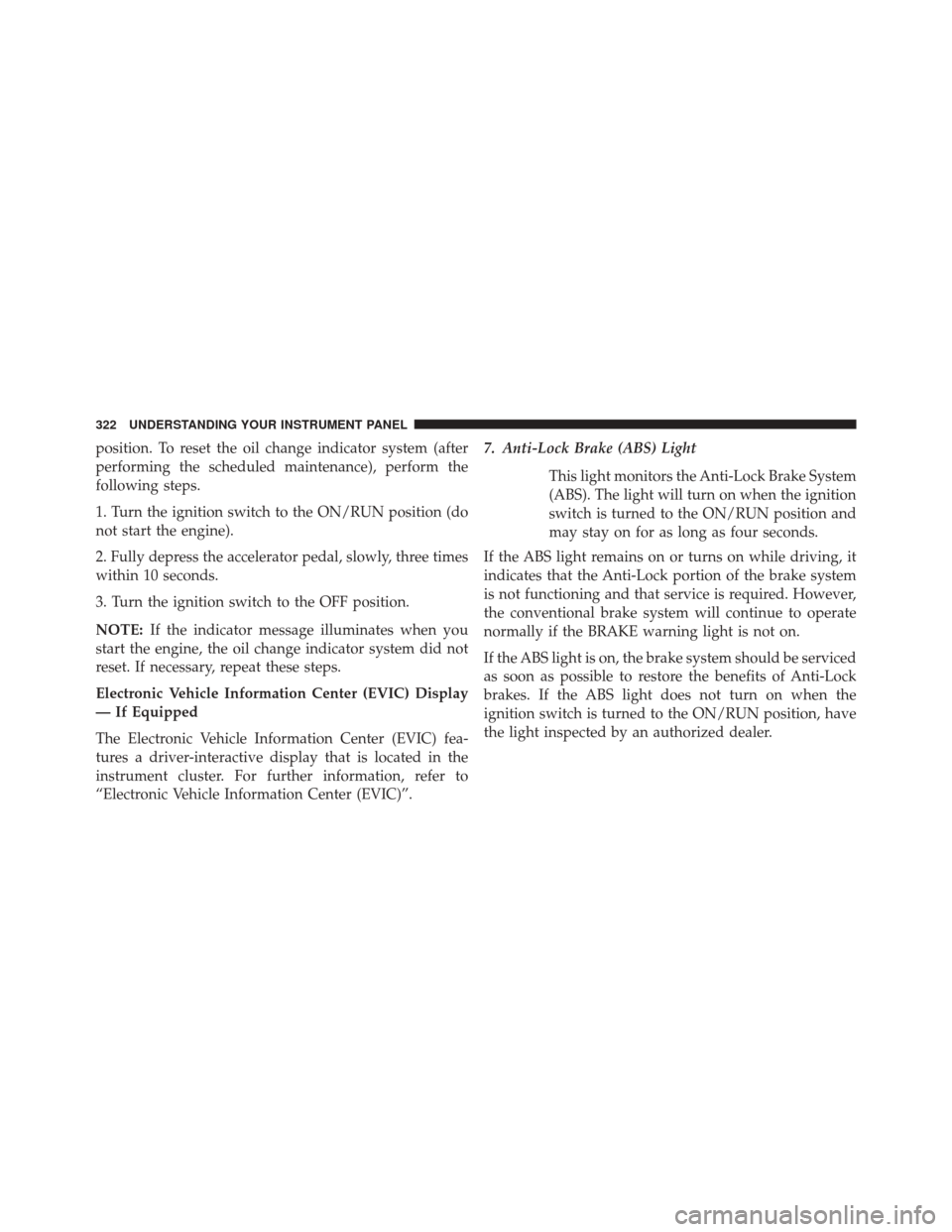
position. To reset the oil change indicator system (after
performing the scheduled maintenance), perform the
following steps.
1. Turn the ignition switch to the ON/RUN position (do
not start the engine).
2. Fully depress the accelerator pedal, slowly, three times
within 10 seconds.
3. Turn the ignition switch to the OFF position.
NOTE:If the indicator message illuminates when you
start the engine, the oil change indicator system did not
reset. If necessary, repeat these steps.
Electronic Vehicle Information Center (EVIC) Display
— If Equipped
The Electronic Vehicle Information Center (EVIC) fea-
tures a driver-interactive display that is located in the
instrument cluster. For further information, refer to
“Electronic Vehicle Information Center (EVIC)”. 7. Anti-Lock Brake (ABS) Light
This light monitors the Anti-Lock Brake System
(ABS). The light will turn on when the ignition
switch is turned to the ON/RUN position and
may stay on for as long as four seconds.
If the ABS light remains on or turns on while driving, it
indicates that the Anti-Lock portion of the brake system
is not functioning and that service is required. However,
the conventional brake system will continue to operate
normally if the BRAKE warning light is not on.
If the ABS light is on, the brake system should be serviced
as soon as possible to restore the benefits of Anti-Lock
brakes. If the ABS light does not turn on when the
ignition switch is turned to the ON/RUN position, have
the light inspected by an authorized dealer.
322 UNDERSTANDING YOUR INSTRUMENT PANEL